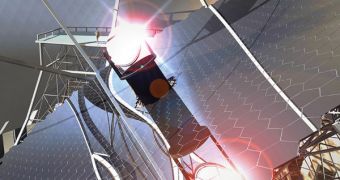The volcanic dome of Mauna Kea, in Hawaii, has been recognized for many years as one of the most suited locations for building ground-based telescopes. Its unique vantage point allows telescopes built here to make out details of the Universe that can only be seen from only a handful of other places around the world. As such, it is here that the new Thirty Meter Telescope (TMT) will be constructed. The observatory is among the first in a series of super-advanced, Earth-based facilities that will innovate the field of astronomy in the next five to 15 years, making previously unknown objects visible.
According to Wired, the gigantic instrument will have an aperture of no less than 30 meters, or a whopping 100 feet. This will allow it to produce images with nine times the current collection power of the twin Keck Telescopes, and also to create photos with 12 times the resolution the Hubble Space Telescope is currently capable of, after its overhaul. The entire project, which costs less than $1 billion, is scheduled to be completed by the end of 2018, its operators announce.
“As we learn more, the cosmos become more mysterious and require[s] more human ingenuity to get to the next step,” Jerry Nelson says. He is a physicist at the University of California in Santa Cruz (UCSC), and also a project scientist for the TMT. The most promising area of research for the new telescope is located at the very edge of the Hubble Deep Field. In these images, some structures appear as small smudges, and astronomers have no idea what they are, because the telescope is unable to see that far into the Universe. Experts hope that the TMT will break this limitation, and reveal important details about the first structures to appear in the Universe.
In the field of exoplanetary research, astronomers will be able for the first time ever to view light coming in from distant exoplanets directly, without having to determine their traits from variations in their parent stars' brightness. This will allow experts to infer characteristics such as atmospheric chemistry and dynamics, which are essential to determining if some of them are habitable or not. The “Dark Ages” of the Universe will also be unraveled, as the observatory will be able to see as far back as the time when the first lights (early stars and galaxies) appeared in the cosmic void.
As opposed to the Keck Telescopes' ten-meter, 36-segment main mirror, the TMT will sport a huge, 30-meter, 492-segment mirror. This is more than one order of magnitude above, and the difference will be enough to allow scientists to peer into things such as the nature of dark matter and dark energy, the telescope's team says. In addition to the University of California system, other institutions participate in the $970-million project, including the California Institute of Technology (Caltech), Canada, Japan, and the Gordon and Betty Moore Foundation. The latter contributed about $200 million to the project.

 14 DAY TRIAL //
14 DAY TRIAL //